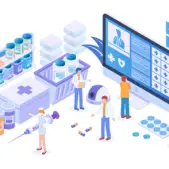Digital experiences are no longer judged within industries; they’re benchmarked against the best experiences anywhere. Whether you’re a health insurer, a utility provider, or a financial institution, your customers now compare your website, app, and support channels to Amazon, Apple, Spotify, and other brands they interact with every day.
They expect intuitive design, effortless navigation, real-time support, and seamless self-service. And if you’re not offering it? They’ll notice.
In fact, research shows that 73% of customers expect companies to understand their needs and expectations, and 66% expect interactions to be connected across channels (Salesforce, State of the Connected Customer). And yet, many organizations, especially those in highly regulated or legacy-driven sectors, are still falling short.

The Rising Bar for Digital Experiences
Consumers now demand digital interactions that are:
- Personalized: Tailored content and recommendations based on individual preferences.
- Efficient: Quick access to services and information with minimal friction.
- Seamless: Consistent experiences across various devices and platforms.
- Empowered: Tools that allow users to manage their needs independently.
These expectations are no longer exclusive to retail or tech industries. For instance, the healthcare sector has seen a significant shift, with patients seeking digital experiences that mirror the convenience of other services. A 2025 J.D. Power study highlighted that health insurance members increasingly use digital channels as their primary means of communication. However, the quality of these digital experiences often lags behind other industries like financial services and automotive finance.
Digital Expectations Are Being Redefined And Not By You
Tech giants are entering every vertical. Amazon’s pharmacy delivery service, Apple’s health and fitness integrations, and Google’s personal finance tools are just a few examples of how platform companies are reshaping the standard for digital simplicity—no matter the industry.
And their influence is real. A customer who can order a car, groceries, and a doctor’s appointment in under 10 minutes doesn’t want to download a PDF to update their address or wait 48 hours for an email confirmation.
“A quick illustration: since the onset of the coronavirus pandemic, my 93-year-old mother has figured out how to bank, pay bills, and order groceries online. And she now uses FaceTime and Zoom to stay connected with family and friends. These new digital activities have quickly replaced her old, “analog” way of doing things. As an elderly woman, my mother certainly isn’t the target market for digitalization but she learned how intuitive and easy many digital interactions can really be. Yet — and here’s the kicker — she still calls her health insurance company with questions about her bill because the member portal is too confusing and difficult to use.”
Consumers of all ages have been conditioned to expect intuitive, fast, mobile-first interactions; and they’re not lowering those expectations just because your business model is complex.
The Rising Bar for Digital Experiences
The companies winning today aren’t necessarily the biggest—they’re the ones who invest in digital experiences that respect people’s time.
- In retail, brands like Nike and Sephora offer personalized journeys across mobile, web, and in-store.
- In finance, neobanks like Chime and Revolut built loyalty by simplifying traditionally clunky processes.
- In logistics, companies like UPS and FedEx now provide real-time delivery updates with proactive alerts—standard expectations that are creeping into every industry.
These aren’t just nice-to-have features anymore. They’re the new baseline.
Why Many Industries Are Still Playing Catch-Up
If your organization is still struggling to deliver smooth, customer-centric digital experiences, you’re not alone. But understanding why you’re behind is the first step to moving forward.
1. Legacy Infrastructure
Many industries are anchored by aging systems that weren’t designed for agility. Core platforms may be decades old, difficult to maintain, and even harder to integrate with modern technologies. These systems limit what teams can deliver, forcing customer experience (CX) and product teams to build new features around outdated foundations.
For example, in sectors like banking, healthcare, and government, modernizing legacy architecture is consistently cited as a top challenge to innovation.
2. Internal Silos and Organizational Inertia
Complex internal structures often mean no single owner is responsible for the full customer journey. Marketing, product, IT, and customer support may all touch the experience—but without shared goals or coordinated efforts, the customer feels the gaps.
3. Misaligned Incentives
Unlike consumer-first brands that fight for loyalty daily, some organizations operate in markets where customer churn is less visible or less painful. For example, an insurance member may stay with the same provider for years—not out of loyalty, but because switching feels like a hassle. The result? Less urgency to improve experiences until retention begins to slip.
How to Modernize Your Digital Experience—Without Rebuilding Everything From Scratch
You don’t need to reinvent your entire organization overnight. But you do need to start investing in digital experience as a core competitive differentiator. Here’s how:
1. Start With a UX Audit
Use analytics, heatmaps, usability testing, and stakeholder interviews to identify pain points. What are customers trying to do—and where are they getting stuck? Even simple insights, like high drop-off rates on key pages or call center volume tied to digital confusion, can guide your next move.
2. Address Tech Debt, One Layer at a Time
You don’t have to rip and replace every system. Consider composable or headless architecture that allows you to modernize the front end while gradually updating the back end. APIs and middleware can help bridge legacy systems and modern interfaces.
3. Build a CX Roadmap With Short- and Long-Term Goals
Balance quick wins (like fixing a broken form or improving mobile layout) with strategic investments (like rethinking the onboarding flow or creating an integrated support dashboard). Small improvements add up fast.
4. Learn From Consumer-First Brands
Borrow from proven design patterns. Chat support, personalized dashboards, interactive FAQs, and mobile-first design aren’t just for eCommerce—they’re applicable everywhere. Implement features your users already understand and value.
5. Empower Teams With Cross-Functional Ownership
Create shared KPIs across departments to align around customer success. For example, instead of measuring success by how fast a support ticket is closed, focus on how often issues are avoided in the first place.
Embracing the Future of Digital Engagement
Customers don’t just compare you to your competitors anymore. They compare you to every digital experience they love.
If your organization wants to earn and keep their trust, your digital products need to be just as thoughtful, usable, and efficient as the apps they rely on every day. That means putting people, not just process, at the center of your transformation.
Because when you make it easy for people to get what they need, they come back.


